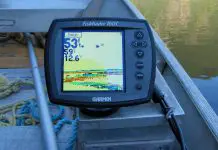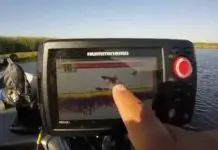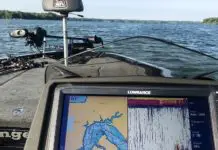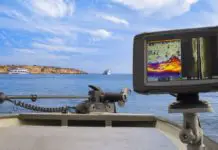
The transducer is the device that sends out and receives the echoes that your fish finder displays on its screen. It uses the same technology as SONAR. The transducer sends out waves in a cone shape underneath your boat(from wherever it is mounted). As the waves bounce back, the transducer picks them up, sends them via wire to the main fish finder unit, and the unit shows the readings in a visual form on its display.
When you buy a fish finder for the first time, a transom mount transducer is usually included. Remember: if you buy a new transducer, it has to be from the same brand, otherwise the plugs wont fit! You also need to match the transducer frequency/wattage to the finder units frequency and wattage.
The general set up for a fish finder on any boat is like this:
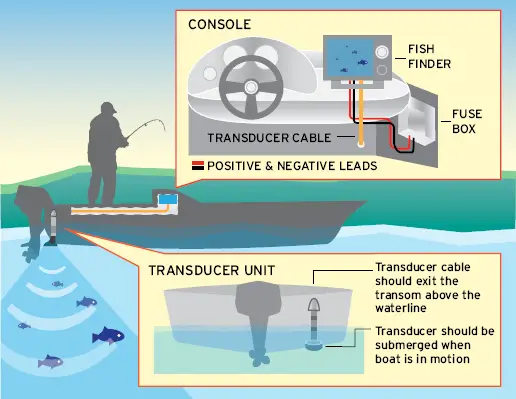
Transom Mount Transducers
Transom mount transducers are the transducers that usually come in the box with most of the fish finder units that we stock at Fish Finder Source. These are fitted on the boat’s transom, at a place that sits completely submerged in the water, and where it will stick a little below the hull. Transom mounts are made of plastic and are usually cheaper than other mount types.
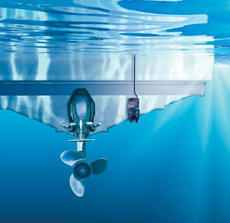 This type of transducer is recommended for planing hulls that are less than 27 feet(8 meters). Examples of such vessels are personal craft and powerboats with outboard, inboard-outboard and jet drives.
This type of transducer is recommended for planing hulls that are less than 27 feet(8 meters). Examples of such vessels are personal craft and powerboats with outboard, inboard-outboard and jet drives.
Using them on larger or twin screw inboard boats is not a good idea because the bubbly water from the props will interrupt the signals. They don’t work too well at very high speeds, either.
This mount is ideal for trailered boats, and is very easy to install and mount.
In-Hull Mount Transducers
Transducers that have In-Hull mounts are mounted(glued or epoxied) on the inside of the hull, at a position that’s outside is always underwater.
In-hull mounts can only be used in fiberglass hulls. They will not work with metal or wood hulls as they disrupt the sonar waves. Additionally, the fiberglass hulls must be solid and have no pores or air pockets – this will further disrupt the signal.
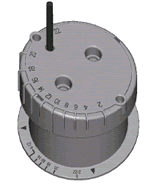 The great part about in-hull mounts is that they can be installed AND serviced while the vessel is in the water. Since they don’t stick out of the hull, they don’t cause any extra drag in the water, they don’t accumulate marine plants and growth, and are very easy to maintain, as the unit won’t be damaged when the boat is trailered.
The great part about in-hull mounts is that they can be installed AND serviced while the vessel is in the water. Since they don’t stick out of the hull, they don’t cause any extra drag in the water, they don’t accumulate marine plants and growth, and are very easy to maintain, as the unit won’t be damaged when the boat is trailered.
In hull mounts give great readings at high speeds, don’t need any holes drilled in the hull to install. The main disadvantage is that it can only be used for fiberglass hulls, and that slight disturbance can sometimes mess up the reading. Some fiberglass hulls are reinforced with balsa or some other material – this will again interrupt the signal. It is best to use a spot where there is no such reinforcement.
Through-Hull Mount Transducers
Through Hull mounts are of two kinds: flush mounts and external mounts. Flush mounts sit flush with the boat hull, and are best for smaller boats that have a minimum deadrise angle. They are used on sailing boats because they produce minimal drag.
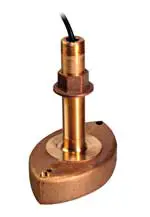 External mounts stick out of the hull surface and normally need a fairing block to aim the SONAR beam correctly. These are generally used for larger vessels that are always in the water and not trailered. It also has to be mounted in front of the propeller and any moving gear to produce the most effective signal.
External mounts stick out of the hull surface and normally need a fairing block to aim the SONAR beam correctly. These are generally used for larger vessels that are always in the water and not trailered. It also has to be mounted in front of the propeller and any moving gear to produce the most effective signal.
Image credits: BoatUS magazine, Raymarine
























